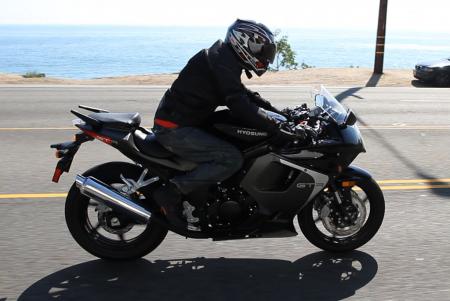2013 Hyosung GT250R Review - Motorcycle.com
With Hyosung facing stiff competition in the form of Honda’s CBR250R and Kawasaki’s Ninja 300, the Korean company throws several updates at its GT250 platform for the 2013 model year. The upgrades go beyond a few new graphics options to focus on better performance in key areas such as electronics and suspension.
In the electronics department Hyosung traded its in-house ECU for one built by electronics giant Delphi – similar to the system used on the company’s ST7 cruiser since 2010 tested here. The bike’s fuel injection system remains a mixed bag but it is also (mostly) a Delphi product now as well. Hyosung’s Garrett Wong says the new ECU and fuel injection system offers a major improvement in high-altitude performance.
Our experience riding the GT250R around coastal California’s elevation was a positive one regarding the Hyosung’s ability to start, idle and accelerate, whether at sea level or up to 3,000 feet in elevation.
The other new development, the GT250R’s KYB suspension, doesn’t require a specific altitude to confirm its performance. The fork and single shock provide a smooth ride in normal street duties, but they become overwhelmed when riding the bike aggressively. The inverted front end may look impressive, but we weren’t impressed with the level of feedback it transmits, and larger riders complained that it squirms when in the canyons. The shock offers a preload adjuster but that’s the only adjustable element of either component.
Compared to other bikes in its class such as the Ninja 300 and CBR250R (a shootout is forthcoming), the Hyosung is built to full-size standards with a high 32.7-inch seat height, 56.5-inch wheelbase and heavy (for a quarter-liter bike) 416-pound curb weight. It’s a bike seemingly designed for beginner riders with larger physicalities, but no matter your size, the combination of the above coupled with the long reach to the below-the-triple-tree-mounted clip-ons is uncomfortable after only a short time spent in the bike’s saddle. In the canyons the aggressive seating position feels natural, asking you to go faster until the suspension warns you to slow down.
Adjustable footpegs – no longer covered with rubber inserts to provide improved feedback – help assuage its uncompromising seating position. However, we were unable to drag its pegs with them set in their lowest position, so there’s no real benefit to their adjustability. In addition to footpegs, the GTR boasts adjustable clutch and brake levers as well as a dimmer function for the gauges. Beware the speedo’s reading, however, as ours conveyed a velocity at least 10% higher than the true speed we were travelling. The plastics used for the gauges and cockpit appear to be lower quality than found on its Japanese competition.
The GT250 is let down by a clunky and imprecise transmission. While far from being considered a smooth shifter, it was the gearbox’s insistence of popping out of 2nd gear that really irked us. This happened so many times during our evaluation we lost count, but it mainly occurred when the engine was cold, although it also happened after being warmed up. Hopefully Hyosung will next put some R&D effort into this now long-in-the-tooth powertrain.
Other improvements for 2013 include new two-tone colors and a restyled upper cowling. And the best news of all is the lack of increase in the bike’s MSRP from last year to now. It starts at $4099 for solid colors and jumps an extra $200 for two-tones.
However, at $4100 the GT250R is only a hundred bucks less than the very capable Honda CBR250R. Honda builds the CBR in Thailand to keep its price low, yet it has a much greater attention to detail than the Korean-built Hyosung. We scratched our heads when we looked at its chrome muffler and its speedo cable haphazardly strewn around the left fork leg.
As more technology begins trickling down to motorcycles at the affordable end of the performance/price spectrum (the CBR250R is available with ABS and the Ninja 300 with ABS and a slipper clutch), Hyosung may begin struggling to stay relevant in the face of its Thai-built and Japanese-engineered rivals.
On the other hand, the simplicity of Hyosung’s air-cooled V-Twin and its full-size dimensions are facets neither the Honda nor the Kawasaki offer, and some riders may be attracted to the Hyosung for these reasons.
More will be revealed in our upcoming shootout, but for now the Hyosung GT250R stands on the merits of its past accomplishments as well as the upgrades to this year’s model. If a dealer’s willing to lower the GTR’s price to something below $4K, then you’d really have a bargain to consider, especially for a brand new bike with a two-year warranty.
Related Reading
2013 Kawasaki Ninja 300 Review
Motorcycle Beginner: 2011 Honda CBR250R Newbie Review
2013 Hyosung GV650 Aquila Pro Review
2012 250cc Cruiser Shootout - Video
2012 Star V Star 250 Review
2012 Honda Rebel Review
2012 Dual-Sport Shootout - Video
2011 250cc Beginner Bike Shootout
2009 250cc Streetbike Shootout
Quarter-Liter Supermoto Shootout
1997 250 Streetbike Shootout: Honda CB250 Nighthawk 250 vs Kawasaki Ninja 250R vs Yamaha Virago 250
More by Tom Roderick
































Comments
Join the conversation